Build a Simple RC Boat Hull
Want plans for this project? Get them at the Plan Store.
A scratch built RC boat hull that is easy and inexpensive. Learn to scratch build with this simple project. Plans are now available for download.
This RC boat hull building instruction goes hand-in-hand with the plans available for download. The hull, and entire boat, is designed to be a relatively easy project.
Before you email me asking if I think this is a suitable project for you, I'd like to offer the following advice: Read through the building instructions and any pages that it may link to and make your own guess first. I'm willing to bet your guess will be better than mine anyways:)
Introduction
Read a short introduction to this new series of small RC model boats to learn more, what materials you'll need etc.
Tools
Here are some of the tools I ended up using for building this RC boat hull.
Tools:
- Scissors
- Razor blades or X-acto knife (or both)
- Steel straight-edge
- Small square
- Pencil
Glue:
- Thin CA (cyano acrylate) glue
- 3M Spray Mount Repositionable Adhesive #6065 or similar
Print out the templates
Start by printing out all the plan sheets that you downloaded. Consider printing out a second set for reference and/or just in case...
Next it's time to cut out the templates, starting with the bulkheads, transom, keel, deck and chine shelf (Item "A").
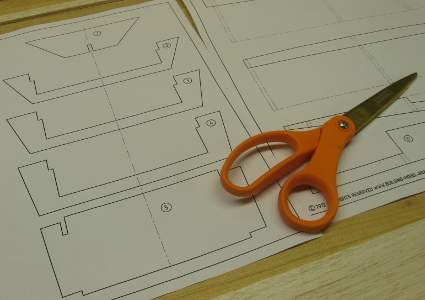 Printed sheet of RC model boat templates.
Printed sheet of RC model boat templates.Cutting out the Templates
A word of caution, don't cut too close to the outline at this point. You can safely stay 1/16 (1.5mm) outside the perimeter of each part.
In addition, parts that get thinner in the middle or are generally "spindly", (bulkheads #2, 3 and 4, keel, deck and chine shelf) are best not to cut out the internal area for the template to maintain its integrity.
Lay Out the Templates on Balsa
Next lay them out on your 1/8" (3mm) balsa sheets. Try not to just throw them on if you want to conserve material, but don't place them too close together either.
Leave 1/8" to 1/4" (3-6mm) between the outline of the parts. Once your happy with the layout you can pencil in the outline of the templates onto the balsa, or take a picture, so you remember where each piece go.
Use the Spray Mount adhesive to glue the templates in place. Follow the instructions on the can.
Cutting and Trimming
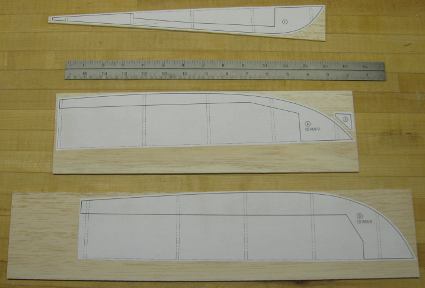 Some of the templates laid out on balsa. Note how the paper "hollow" inside the templates is left to maintain the integrity of the shapes.
Some of the templates laid out on balsa. Note how the paper "hollow" inside the templates is left to maintain the integrity of the shapes.At this point all templates should be glued to the balsa with the Spray Mount Adhesive, essentially turning the templates into over-size sticky notes. Now it's time to start cutting out the parts.
Separate each part from the sheet first by using a razor blade or X-acto knife and a metal straight-edge. At this point don't worry about the templates, except not to cut into them. This step is just to separate the pieces so they can be trimmed later.
You don't need the straight-edge, but it is infinitely easier to make a cut if you do, and the risk of slipping and cutting into a template is greatly reduced. If you have a scroll saw or band saw it can be put to good use at this step.
As the pieces are separated from each other, there will be excess material surrounding the templates. Now it's time to trim that down. I tend to do it in successive steps and using the straight-edge as much as possible. The resulting angles will be taken off at the final trim.
I also tend to start with the outside shape and do any internal areas last, otherwise the pieces can break and split easily.
Making Multiple Pieces From a Single Template
Also note that the deck and chine shelf templates only account for one half of the hull, so you need to make two of items "A" and "B". The same goes for the knee (item "E").
The best way to make two identical parts is to sandwich two sheets of wood under the template and cut through the stack. Two issues emerge:
How to hold the sandwich firmly together while cutting?
The best way I've found is to first attach the template to one of the sheets of balsa and trim the balsa roughly to the template with a razor blade or X-acto knife.
Next, leaving the other half oversize, glue it to the first half using two tiny dots of CA glue. The amount of glue is relatively important - too much glue and you won't be able to get them apart etc.
How to make a perpendicular cut through both sheets?
Making a perpendicular cut free hand on balsa is difficult. If you're just a little off perpendicular the two halves will be different size and the whole point of sandwiching the material is lost.
The way I do it is to trim the sandwiched parts until all you've got left is an even 1/16" (1.5mm) of balsa surrounding the outline of the template. To get to finished size I trim off the last bit with 80 grit sandpaper on a hard sanding block. I often lay the balsa over the edge of my work table and that way have an easier time keeping the angle straight.
Final Trim
With the exception of multiple parts from one template (as outlined above) parts with straight edges are best cut to finished size with the knife and straight-edge.
For rounded edges there will be excess material coming off as angles. This is best dealt with using a wooden sanding block and 80 grit sand paper. Start at the angled peaks and work your way around the perimeter.
When sanding, your strokes need to go in one direction only. from the template side towards the back so you don't lift the template off the wood. You can put some angle to it, but you get the general idea.
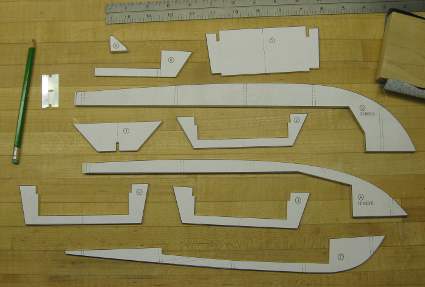 Here are all the parts for the RC boat hull with templates still attached.
Here are all the parts for the RC boat hull with templates still attached.The last thing to do is to trim mortises and the internal areas as mentioned earlier. Once all done you should have a set of parts like in the picture above.
Transfer Lines From Templates to Parts
At this point its tempting to peel off the templates, but hold your horses - we're not quite ready for that yet. Instead we need to transfer relative position from the templates to some of the parts to aid the assembly for accurate position and alignment.
The best tools for the job is a small square and a sharp, relatively soft, lead pencil.
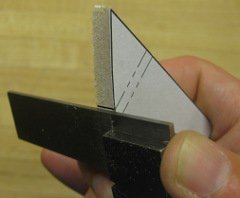 A small square is used to transfer alignment and position marks to the balsa.
A small square is used to transfer alignment and position marks to the balsa.The parts that get the treatment are chine shelf, keel, deck, and transom. Having the center line marked on the outside of the transom will help in aligning the keel and rudder.
The other components need marks to give the relative position for the bulkheads. Only one line is required per bulkhead, but I typically mark the position for both edges so I don't have to remember if the bulkhead goes in front of or behind the line. With two lines, I know the bulkhead goes between.
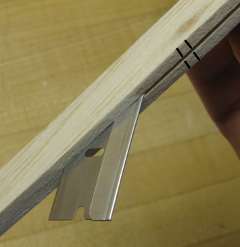 Separating the doubled parts.
Separating the doubled parts.Once the necessary marks are made, you can safely peel off the templates with one exception: Leave the template on the keel in place for now. The parts that were doubled can be separated as shown in the picture. Some wood will most likely separate from one side, but it's not enough to worry about.
Dry Fitting the RC Boat Hull
Dry fitting is the first and most important step as the hull is being constructed. This is a good opportunity to trim and fix minor flaws that may have worked its way in at this point. Better to remake one erroneous part than an entire assembly, so take your time.
Dry fitting also helps you familiarize yourself with the pieces that make up an assemble and help you figure out which order to attach the parts while retaining good alignment and integrity.
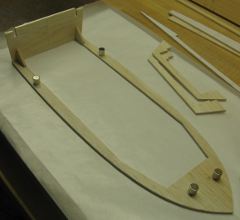 First dry-fit of both chine shelf halves, transom and two knees.
First dry-fit of both chine shelf halves, transom and two knees.The most important tool to make a straight hull is a flat surface to build it on. It is good if you can drive pins into it, lay weights or use magnets to hold the chine shelf down flat on the building board or table top.
Lay down the Hull Alignment Template on your building board and lay a sheet of wax paper or plastic food film (Seran Wrap or similar) over to prevent the model to stick to the template and your table. I've found the wax paper resist CA glue better, so that's what I use.
Secure the sheets to the board with a method suitable for the type of building board you're using - it can be pins, tape, weights etc.
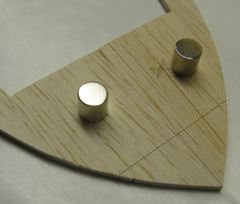 Detail of the front end of the chine shelves on the building board. Three points line up perfectly: the stem, bulkhead position and inner front edge.
Detail of the front end of the chine shelves on the building board. Three points line up perfectly: the stem, bulkhead position and inner front edge.When I built the prototype I didn't have the hull alignment template, so you'll see the template is missing in the pictures on this page. Assembly should be a lot easier and almost self explanatory with the template.
Align the two halves of the chine shelf on the hull alignment template. Pin or weigh them down once they are in position. There three most important places to check for proper alignment are:
- The pinnacle of the stem
- The rear edge
- The inner edge at the stern
If all three of these line up with the template, secure them in place to the board and glue them together with a couple of drops of CA glue where they join at the front.
There are a few other less important points that should line up, such as the inner front edge and the lines drawn for the #1 bulkhead.
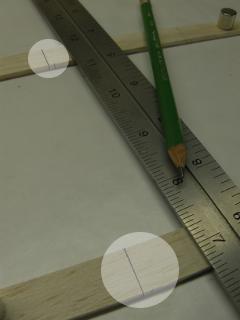 Drawing lines to highlight the bulkhead positions.
Drawing lines to highlight the bulkhead positions.Take a straight-edge and pencil and draw lines connecting the bulkhead position marks you made from the templates to aid bulkhead placement later on.
Earlier we marked both front and rear edge of the bulkheads onto the balsa. Now I usually only connect one set of those tick-marks, using the other set as a visual guide for bulkhead placement.
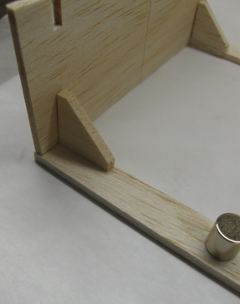 Detail of transom, chine shelf and knees glued together.
Detail of transom, chine shelf and knees glued together.Place the transom (item "5") in-between the two chine shelf pieces and line it up with even on the left and right hand side. Use the two knees (items "E") to establish the correct angle for the transom. The knees should line up with the inner edges of the chine shelf (see pictures), but their placement is not critical.
Sometimes the parts will stay in place by themselves, other times they need pins. Try and eliminate any gaps. Either way, once the placement is right, attach the pieces with small drops of CA glue at the joints. Be careful not to bump the parts out of position.
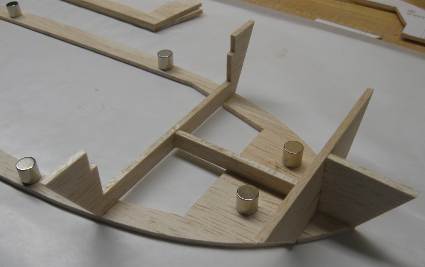 Front assembly of stem piece and bulkhead #1 and 2 attached to hull.
Front assembly of stem piece and bulkhead #1 and 2 attached to hull.Next dry fit the stem piece (item marked "D") and bulkhead #1 and lay them in position with stem piece centered on the hull center-line and the bulkhead in it's marked position.
Check and make sure they are perpendicular to the building board and each other. The position of the stem piece is more important than the bulkhead, so pay extra attention to it. Once they're in position, glue them in place.
Take bulkhead #2 and align it as well. Check and make sure it is centered by checking against the edge of the chine shelf - it should over/under-shoot equally on either side. Where the tail end of the stem piece meet the bulkhead is less important.
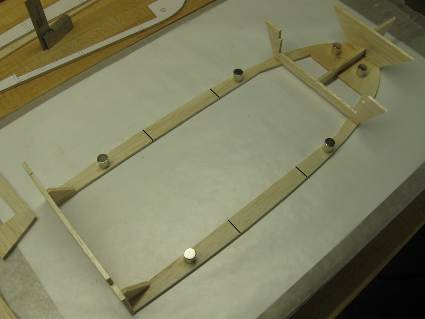 A bird's eye view of the rc boat hull so far.
A bird's eye view of the rc boat hull so far.Do the exact same for bulkhead #3 and 4.
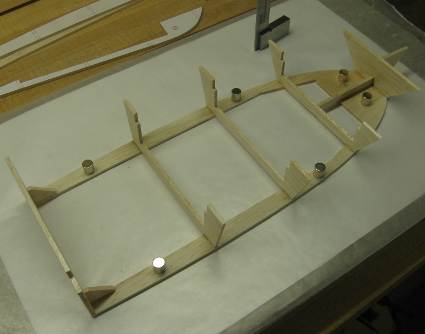 Bulkhead #3 and 4 attached.
Bulkhead #3 and 4 attached.Cut the two deck stringers from a 1/8" x 3/8" (or 3 x 10mm) balsa stick and glue in place. You can leave it long at the transom end and trim it with an X-acto Razor Saw for example.
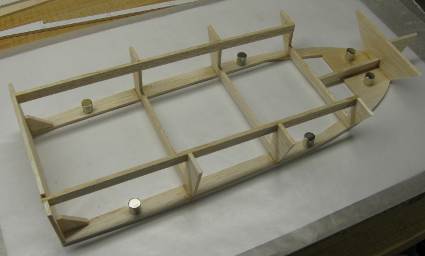 Deck stringers in place.
Deck stringers in place.The rc boat hull assembly is now fairly rigid and likely to stay straight and true. In the next installment we'll focus on the deck, keel and lower part of the hull structure before moving on to some internal installations and planking.





